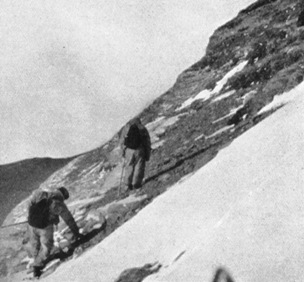
Mountaineer
Late in 1932, Wager was invited to join the 1933 Everest Expedition as a last-minute replacement for Noel Odell. Wager, Hugh Ruttledge, the expedition leader, Jack Longland and Percy Wyn-Harris arrived at Darjeeling on February 17 and began the long trek to Everest, climbing up to 14,900 ft at the Tibet boundary. Wager arrived at Base Camp with the ‘hill trots’ and needed a week to recover. On May 29, Wager, Wyn-Harris and Longland with eight porters reached Camp VI and on May 30, Wager and Wyn-Harris made the first assault on the summit.
They reached about 28,100 ft, approximately the same point as Norton and Summerville had reached in 1924 but were blocked by the ‘second step’ which Wager considered unclimbable. Nonetheless, this was the highest on Everest without oxygen until Reinhold Messner and Peter Habeler made their successful ascent in 1978. Wager and Wyn-Harris then returned to Camp VI, where the second summit party consisting of Frank Smythe and Eric Shipton was waiting. They ascended to the same point but did not get any higher. During their descent, Wager forced himself up to the NE shoulder of the mountain, becoming the only climber to have looked down on the SE face of Everest until Hillary and Tenzing did so 20 years later. When Dr McLean, the expedition Medical Officer, examined Wager and Wyn-Harris in the camp, he found both had dilated hearts.
When Wager arrived home, he was obliged to lecture around the country to raise money for the Mount Everest Committee as well as to continue with his teaching and research at Reading. When he had arrived at Reading, the Geology Department only had two rooms called ‘The Hut’ but they moved into new labs in 1931. Wager was not a natural lecturer but he managed to fascinate the students with petrology all the same. However, immediately after his lectures, he would stalk back to his room on the hour, bang the door shut and get on with the Skaergaard struggle. He was at his best with students in the field, unravelling geological problems before their eyes.
The Wagers spent July 1938 in Norway and took the opportunity to visit V.M. Goldschmidt at his home. This was to be the only meeting between Wager and Goldschmidt, although they corresponded later and Wager’s group at Oxford subsequently devoted considerable effort to testing the validity of the Goldschmidt Rules based on geochemical data from the Skaergaard rocks.
In March 1940, Michael Spender visited Wager in Reading to discuss a photogrammetric machine he had imported to England for interpreting air photographs. Wager knew Spender from the Mikkelsen Expedition to East Greenland in 1932 where Spender had made a fine map of 1,000 sq miles of Kangerdlugssuaq using stereo-photogrammetric surveying. In May, Wager was persuaded to join the Photographic Interpretation Unit of the Air Ministry as a civilian. He was commissioned into the Royal Air Force Voluntary Reserve (RAFVR) in August and in 1942 volunteered to lead a small photographic interpretation unit to Murmansk to trace the key German ship the Tirpitz. While in Murmansk, the Tirpitz was found with the aid of their three long-range reconnaissance Spitfires and they were ordered home, much to Wager’s relief. The Tirpitz was eventually sunk in November, 1944, off Tromsø in Norway. Wager had survived the notorious Murmansk run and was Mentioned in Despatches.
In 1943, Wager was appointed to succeed Arthur Holmes as Professor at Durham but was only released from the RAFVR after Lord Eustace Percy, the Vice-Chancellor of Newcastle University, wrote to his friend, Sir Archibad Sinclair, the secretary of State for Air. At Durham, Wager helped found Geochimica et Cosmochimica Acta (Shaw 2003), the first volume of which carried his classic paper on the geochemistry of the Skaergaard intrusion with Robert Mitchell. Wager remained an editor of GCA until his death.
In the austerity of post-war Britain, research in Greenland was out of the question. Accepting the Society’s Bigsby Medal in 1945, Wager said that reconnaissance work in distant places had to be replaced by work of the same exactitude nearer to home. Thus began his work with Fred Stewart, David Vincent, Malcolm Brown and David Bell on the British Tertiary Igneous Province. A year later Wager was made a Fellow of the Royal Society.
Wager’s election to the Oxford Chair of Geology was announced on 6 April 1950. In going to Oxford, Wager was taking over a moribund department and set about creating a modern, world-class geology department by broadening the teaching staff and, over the years, attracting the likes of Louis Ahrens, Ross Taylor, David Vincent, Malcolm Brown, Richard Lambert, Harold Reading. Ron Oxburgh, David Bell and Jack Zussman among others. By the late 1950s, Wager had managed to re-establish the Department of Geology and Mineralogy and had imbued the department with a determined and enthusiastic research spirit.
Wager himself focused on new methods of chemical analysis as pioneered by V.M. Goldschmidt. X-ray fluoresence spectrography became important during this period and was used for analysing Skaergaard samples. In addition, Instrumental Neutron Activation Analysis (INAA) was being developed by Albert Smales and his Analytical Chemistry Group at Harwell and was extensively used at Oxford. This approach led to the investigation of more elements in Skaergaard material. The joint studies with Harwell culminated in the publication of Methods in Geochemistry by Smales and Wager in 1960.